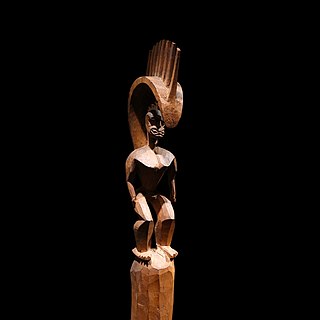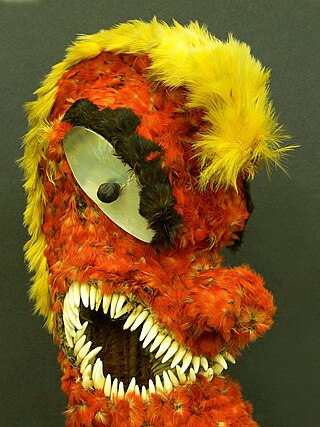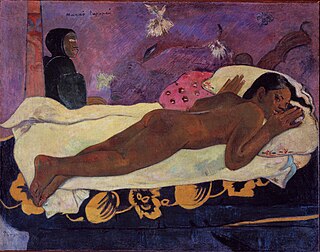In Hawaiian mythology, Kāne-milo-hai is the brother of Kāmohoaliʻi, Pele, Kapo, Nāmaka and Hiʻiaka by Haumea.
In Hawaiian mythology, Kāne is considered the highest of the three major Hawaiian deities, along with Kū and Lono. He represented the god of procreation and was worshipped as ancestor of chiefs and commoners. Kāne is the creator and gives life associated with dawn, sun and sky. No human sacrifice or laborious ritual was needed in the worship of Kāne. In the Kumuhonua legend, he created Earth, bestowed upon it sea creatures, animals, plants, as well as created man and woman.
In Hawaiian religion, Hiʻiaka is a daughter of Haumea and Kāne.
Haumea is the goddess of fertility and childbirth in Hawaiian mythology. She is the mother of many important deities, such as Pele, Kāne Milohai, Kāmohoaliʻi, Nāmaka, Kapo, and Hiʻiaka. Haumea is one of the most important Hawaiian gods, and her worship is among the oldest on the Hawaiian islands. She was finally killed by Kaulu.

In Hawaiian religion, the god Lono is associated with fertility, agriculture, rainfall, music and peace. In one of the many Hawaiian stories of Lono, he is a fertility and music god who descended to Earth on a rainbow to marry Laka. In agricultural and planting traditions, Lono was identified with rain and food plants. He was one of the four gods who existed before the world was created. Lono was also the god of peace. In his honor, the great annual festival of the Makahiki was held. During this period, war and unnecessary work was kapu (forbidden).

In Hawaiian mythology, Laka is the name of two different popular heroes from Polynesian mythology..

In Hawaiian mythology, Kamapuaʻa is a hog-man fertility superhuman associated with Lono, the god of agriculture. The son of Hina and Kahikiula, the chief of Oahu, Kamapuaʻa was particularly connected with the island of Maui.
In Hawaiian mythology, Nāmaka appears as a sea goddess in the Pele family. She is an older sister of Pele-honua-mea.

In Hawaiian religion, Pele is the goddess of volcanoes and fire and the creator of the Hawaiian Islands. Often referred to as "Madame Pele" or "Tūtū Pele" as a sign of respect, she is a well-known deity within Hawaiian mythology and is notable for her contemporary presence and cultural influence as an enduring figure from ancient Hawaii. Epithets of the goddess include Pele-honua-mea and Ka wahine ʻai honua.

Ancient Hawaiʻi is the period of Hawaiian history preceding the unification in 1810 of the Kingdom of Hawaiʻi by Kamehameha the Great. Traditionally, researchers estimated the first settlement of the Hawaiian islands as having occurred sporadically between 400 and 1100 CE by Polynesian long-distance navigators from the Samoan, Marquesas, and Tahiti islands within what is now French Polynesia. In 2010, a study was published based on radiocarbon dating of more reliable samples which suggests that the islands were settled much later, within a short timeframe, in about 1219 to 1266.

The culture of the Native Hawaiians encompasses the social behavior, institutions, and norms practiced by the original residents of the Hawaiian islands, including their knowledge, beliefs, arts, laws, customs, capabilities, and habits. Humans are estimated to have first inhabited the archipelago between 124 and 1120 AD when it was settled by Polynesians who voyaged to and settled there. Polynesia is made of multiple island groups which extend from Hawaii to New Zealand across the Pacific Ocean. These voyagers developed Hawaiian cuisine, Hawaiian art, and the Native Hawaiian religion.
In Hawaiian mythology, Kapo is a goddess of fertility, sorcery and dark powers. Kapo is also known as Kapo-ʻula-kīnaʻu, where "the epithet ula-kinaʻu is used in allusion to the fact that her attire, red in color, is picked out with black spots. The name Kapo alone is the only by which she is usually known." "Kapo is said to have been born of Papa while she was living up Kalihi valley on Oahu with Wakea, her husband. Some say that she was born from the eyes of Papa. She is of high rank and able to assume many shapes at will." She is the mother of Laka, although some versions have them as the same goddess. She is the sister of Kāne Milohaʻi, Kāmohoaliʻi, Pele, Nāmaka and Hiʻiaka.

Hawaiian religion refers to the indigenous religious beliefs and practices of native Hawaiians, also known as the kapu system. Hawaiian religion is based largely on the tapu religion common in Polynesia and likely originated among the Tahitians and other Pacific islanders who landed in Hawaiʻi between 500 and 1300 AD. It is polytheistic and animistic, with a belief in many deities and spirits, including the belief that spirits are found in non-human beings and objects such as other animals, the waves, and the sky. It was only during the reign of Kamehameha I that a ruler from Hawaii island attempted to impose a singular "Hawaiian" religion on all the Hawaiian islands that was not Christianity.

ʻOro is a god in Tahiti and Society Islands mythology. The veneration of ʻOro, although practiced in varying intensity among the islands, was a major religion of the Society Islands in the 17th and 18th centuries, especially Tahiti, Tahaa, Moorea, and Raiatea. On Tahiti, ʻOro was the main deity and the god of war. The secret society of Arioi was closely linked because of its rites. On the Marquesas Islands, ʻOro bore the name Mahui.

In Hawaiian religion, Kū is one of the four great gods. The other three are Kanaloa, Kāne, and Lono. Some feathered god images or akua hulu manu are considered to represent Kū. Kū is worshiped under many names, including Kū-ka-ʻili-moku, the "Snatcher of Land". Rituals for Kūkaʻilimoku included human sacrifice, which was not part of the worship of other gods.

There was widespread belief in ghosts in Polynesian culture, some of which persists today. After death, a person's ghost would normally travel to the sky world or the underworld, but some could stay on earth. In many Polynesian legends, ghosts were often involved in the affairs of the living. Ghosts might also cause sickness or even invade the body of ordinary people, to be driven out through strong medicines.
Waka, in Hawaiian mythology, is a lizard goddess worshipped by female chiefs. In the Ha'inakolo narrative, she was sent in the form of an eel to bar Lono-kai from the land of Kū'ai-he-lani. When Lono-kai caught the eel and cut it open, a beautiful woman emerged who attempted to seduce him. In the Lā'ie-i-ka-wei narrative, Waka acts as the guardian of a beautiful girl until she can find her a suitable husband.

Kihawahine is a Hawaiian shapeshifting lizard goddess (moʻo). When Kihawahine Mokuhinia Kalama‘ula Kalā‘aiheana, the daughter of the powerful sixteenth-century ruling chief of Māui, Piʻilani, and his wife Lā‘ieloheloheikawai, died, her bones were deified, transforming her into the goddess. Kihawahine's home is Mokuhinia, a wetland pond on the island of Moku'ula.












